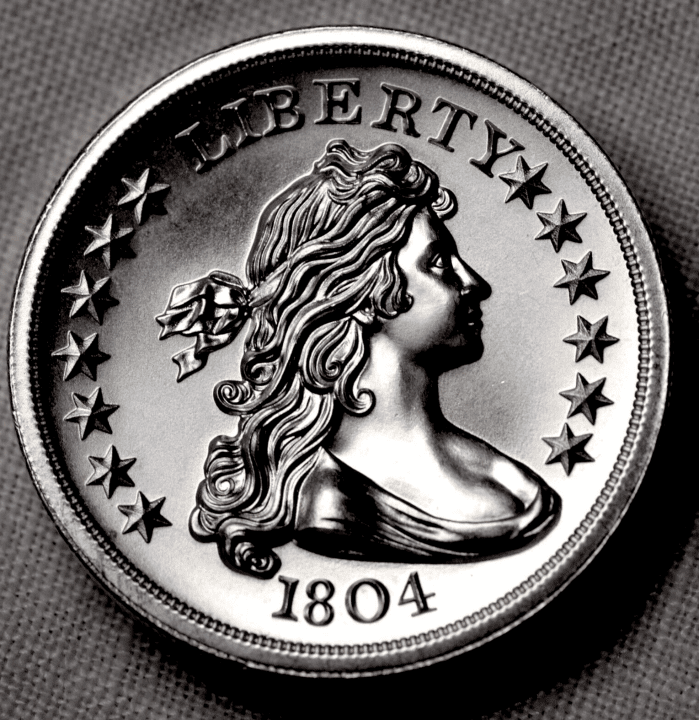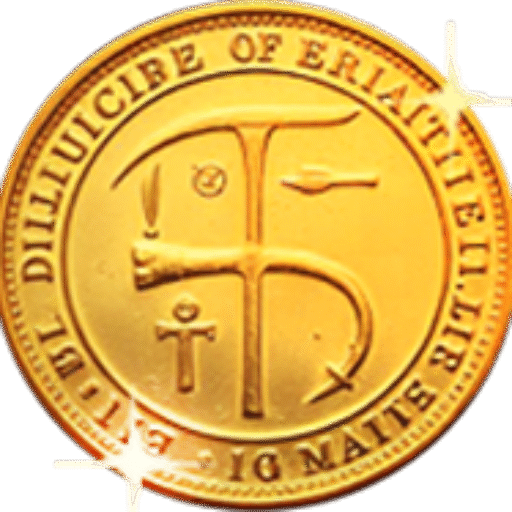An In-depth Study of the 1804 Draped Bust Dollar

The 1804 dollar. The Trade dollars struck at the Philadelphia Mint in 1884 and 1885 were all produced under identical circumstances, with the mandate to create sets of proof coinage for use as diplomatic gifts. However, of the Trade dollar proofs, a few examples of 1884 and the same number of 1885 patterns are saved from oblivion—about twelve or thirteen coins of the 1884 and 1885 Trade Dollar proofs.
The 1804 silver dollar is one of the most famous coins in the world. Only known to exist by researchers and a few coin collectors, the 1804 dollar is a unique coin, and it has become a part of American folklore and has assumed an almost mythical status. However, despite its fame, this coin, like any other coin of the same period, was produced not to satisfy the curiosity of future collectors but to be used for its intended purpose: to pay for goods or services and to facilitate the trading and marketing of private individuals.
Historical Background and Significance
While the hundred or so pieces struck at this time had a fabulous (and indeed unbelievable) history for their monetary value, the artistic design of Robert Scot was the most crucial aspect of them. Scot, who was suggested to the Mint Director at this time by Thomas Jefferson, was a competent artist from Scotland. However, his works at the Philadelphia Mint are somewhat secondary to his activities as a die-sinker for engraving coins and paper money afterward.
He next created the Heraldic eagle as a Bank of North America piece, from which he patterned the familiar United States half dollar in late 1796. After the significant Draped Bust dollars were minted in 1799 and 1800, Scot’s Small eagle design became the basis for the silver coins struck at Philadelphia until the end of 1807.
One primary reason for the severe coin shortage was that the 1792 Congressional Act only authorized the production of gold half eagles, half dollars, cents, and half cents. Of these, the half dollar was the highest unit coin officially authorized for circulation.
Thus, Samuel Moore, honored for his distinction in creating the first United States gold coins and copper pattern coinage about the same time period, took it upon himself to mint a more valuable silver coin. By doing so, he would add to the available silver coins in circulation and thus help alleviate the coin shortage experienced in the nation.
Design and Minting Process
The reverse was by another Mint engraver, John Eckstein. It shows a small eagle (called the “small eagle” variety) perched on a cloud. The bird holds a small shield in its right wing and an olive branch in its talons. The edge lettering on the coin reads “Hundred Cents One Dollar or Unit,” and one or two leaves sometimes separate these words. Another feature of this coin is a symbol called a “border of leaves,” which exists on the reverse outside the stars and the clouds. The diameter of this coin is 39.2 millimeters.
The coin’s weight is the standard weight for all silver dollars: 416 grains. It was struck in coin silver (90% silver and 10% copper). The “dies” for this coin were first rubbed in the side, and these rubbed clichés were used to make dies. The reverse die shows evidence of ever being struck, most notably the alignment from 1804 quarters and dimes, carefully hoarded by collectors when first created.
Engraver Robert Scot first created the design of the Draped Bust Dollar. He was the Chief Engraver of the United States Mint at the time and personally engraved the early dies for the coin. The obverse of the coin shows a bust of Miss Liberty facing right. The word “Liberty” appears above her. There are fifteen six-pointed stars around the coin’s border, seven to the left of Liberty and eight to the right. There have been many rumors regarding who this bust represents.
Some believe it is a portrait of Anne Willing Bingham, while others feel it is a woman named Ann Dagworthy, daughter of Thomas Jefferson’s mother-in-law. The most widely accepted theory is that it is the work of John Eckstein, a Philadelphia model and known beauty who was used as a model to help Scot come up with the design. Also, to the tops of the obverse, a truncation (the line crossing the image in 1796) was added to save money.
Design and Minting Process
The 1804 dollar die varieties are Bluebook-notable because of types among the stars on most reverse dies. Only for the 1800, 1802, 1802/1, 1806, and 1807, it is known that type does not occur among the stars of any reverse die.
Because type should be most prominent on the reverse by being surrounded by stars, type among the 1804 reverse stars is most eye-catching, and thus there are 7 Bluebook-notable examples of this type. Type among the reverse stars is frequently also by far the most of any of the 1804 dollar varieties. Only for the 1804 dollar, there was a small number of overdates and a prominent misplaced date variety.
The Draped Bust Dollar die varieties are frequent and have been described and analyzed several times in the years since then. Most knowledge and sales catalogs are in favor of the 1804. Hence, only for the 1804 dollar are there any variety tables in the famous reference books for early dollars, e.g., in Bowers’ two encyclopedias on U.S. silver dollars, since Bowers nearly always consults the most workable catalog. (Heinecke et al., 2021)
Market Value and Collectibility
A second cause is that the early dollars were made of very high silver fineness, so even at the denomination’s low weight, there was the intrinsic value that stimulated hoarding by the people from whom. As the demand for official minting was so low, it was the least of the mints at which they. It appears to have been something of an unwarranted sortie beyond the half-dollar barrier. The lower denomination had been so persistently and perversely debased to meet the prevailing world silver values that any mint operation revealed an advanced higher value by the people and harassed and alienated the future official business.
Every collector desires to own a Draped Bust Dollar, but the high cost limits its ownership to a select few. There are three reasons for its high price. The first is its scarcity. It was about 20,000 dollars over the first two years. It seems like a mass production compared with a good part of the half-dollar mintage. Still, when one considers the difference in the denomination values, it is easy to see that since the dollar had about the purchasing power of today’s ten dollars, they were not a popular coin. The principal currency for the country lay in silver and gold.









The 1804 dollar. The Trade dollars struck at the Philadelphia Mint in 1884 and 1885 were all produced under identical circumstances, with the mandate to create sets of proof coinage for use as diplomatic gifts. However, of the Trade dollar proofs, a few examples of 1884 and the same number of 1885 patterns are saved from oblivion—about twelve or thirteen coins of the 1884 and 1885 Trade Dollar proofs.
The 1804 silver dollar is one of the most famous coins in the world. Only known to exist by researchers and a few coin collectors, the 1804 dollar is a unique coin, and it has become a part of American folklore and has assumed an almost mythical status. However, despite its fame, this coin, like any other coin of the same period, was produced not to satisfy the curiosity of future collectors but to be used for its intended purpose: to pay for goods or services and to facilitate the trading and marketing of private individuals.